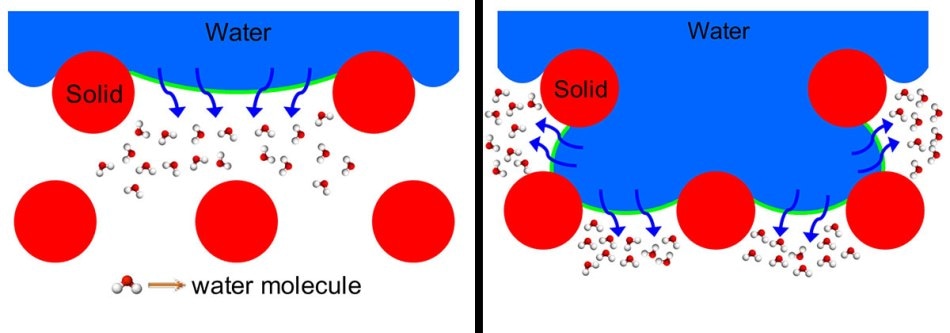Aug 8 2019
Water scarcity is presently a serious challenge all across the globe, and this has caused engineers and scientists to relentlessly work towards finding new ways of harvesting purified water from wastewater or seawater and other such alternative sources.
 Left represents an omniphobic membrane, and right represents a conventional hydrophobic membrane with increased water-air interfacial areas (green lines). Credit: Kota lab
Left represents an omniphobic membrane, and right represents a conventional hydrophobic membrane with increased water-air interfacial areas (green lines). Credit: Kota lab
Colorado State University researcher Tiezheng Tong, who is an assistant professor in the Department of Civil and Environmental Engineering, is currently exploring an emerging technology called membrane distillation in his lab. Membrane distillation deals with a thin, water-repellent membrane capable of exploiting vapor pressure variances between hotter impure liquid, known as feedwater, and colder purified water, known as permeate.
In this process, water vapor passes via the membrane and gets separated from the dirty or salty feedwater. Tong states that membrane distillation functions better when compared to other technologies such as reverse osmosis, which fails to treat produced water from hydraulic fracturing or very salty water like desalination brines.
Membrane distillation does not work perfectly even though it seems to be promising. A crucial challenge is developing membranes to purify water efficiently while guaranteeing zero contamination of the clean water.
Tong and materials scientist Arun Kota in the Department of Mechanical Engineering joined hands to discover the fundamental science behind engineering that perfect membrane. In new experiments, they illustrate in Nature Communications, the CSU engineers provide new information into why specific membrane designs used in membrane distillation function better than others.
The fundamental knowledge from our paper improves mechanistic understanding on the water-vapor transport within microporous substrates and has the potential to guide the future design of membranes used in membrane distillation.
Tiezheng Tong, Researcher and Assistant Professor, Department of Civil and Environmental Engineering, CSU
How it Works
In membrane distillation, the feedwater is heated, isolating the pure and impure components by variances in volatility. The micro-porous membrane is a main component to the installation as it allows water vapor through, but not the whole impure liquid. Generally, the membrane is composed of a “hydrophobic,” or water-repellent, material so as to allow only the water vapor to pass through but keep a barrier for the feedwater.
However, these hydrophobic membranes can flop, because the feedwater, such as shale oil-produced water, may possess low surface tension. This low surface tension allows the feedwater to seep through the membrane pores, polluting the pure water on the other side—a phenomenon known as membrane wetting.
Earlier research had revealed that using “omniphobic” membranes—membranes that repel all liquids, such as water and low surface tension liquids—maintain the vapor/water separation intact. But, omniphobic membranes usually decelerate the rate and amount of water vapor passing via the membrane, greatly reducing the efficiency of the whole process.
The CSU scientists aimed to discover why this compromise between hydrophobic vs. omniphobic membranes exists. Through methodical experiments in the lab headed by postdoctoral scientists Wei Wang in Kota’s lab, and Tong’s graduate student Xuewei Du, they learned that conventional hydrophobic membranes form a larger liquid-vapor interfacial area. This raises the amount of evaporation happening.
With the omniphobic membranes, they witnessed a much smaller liquid-vapor interface. This explains the variance between the membranes’ performances. The omniphobic membranes used in the experiments were produced without depositing additional particles. Therefore, the scientists were able to establish that their observations were not the result of structural variations to the membranes.
Solving the Tradeoff Problem
While they did not provide a solution to the compromise, their insights expose the key challenge around making membrane distillation an effective technology.
If you understand the problem thoroughly, then there is scope for solving it. We have identified the mechanism; now we have to solve the tradeoff problem.
Arun Kota, Materials Scientist, Department of Mechanical Engineering, CSU
For instance, smart membranes with remarkable omniphobicity and simultaneously large liquid-vapor interfacial area can render membrane distillation a strong and economical process for water purification. Further collective research has been initiated by the team to develop such smart membranes, with the goal of boosting efficiency of membrane distillation.
Tong added that the study took place at the interface of two disciplines: membrane technology and surface science.
Arun and I utilized our complementary expertise to systematically conduct this work. It is an example of good interdisciplinary collaboration across campus.
Tiezheng Tong, Researcher and Assistant Professor, Department of Civil and Environmental Engineering, CSU
Graduate students Hamed Vahabi in mechanical engineering and Yiming Yin in civil and environmental engineering also contributed to this research.